![]()
![]()
![]()
Use LEFT and RIGHT arrow keys to navigate between flashcards;
Use UP and DOWN arrow keys to flip the card;
H to show hint;
A reads text to speech;
89 Cards in this Set
- Front
- Back
- 3rd side (hint)
|
Frequency distribution |
A graph of frequencies (number or proportions) of different phenotypes |
|
|
|
Frequency distribution |
Concise method of summarizing all phenotypes of quantitative characteristics |
|
|
|
X axis |
Phebotypic classes |
|
|
|
Y axis |
Frequencies (number or proportions) of individuals in each class |
|
|
|
Normal distribution |
Exhibits symmetrical (bell-shaped) curve |
|
|
|
False |
Since quantitative characteristics are described by a measurement and are influenced by multiple factors then inheritance must not be analyzed statistically |
It is a must |
|
|
Negative skewness |
Right modal |
|
|
|
Positive skewness |
Left modal |
|
|
|
Population |
Group of interest |
|
|
|
Sample |
Smaller collection of individuals |
|
|
|
Characteristics of good sample |
1. Must be representative of the whole population |
Selection thru random sampling |
|
|
Characteristics of good sample |
2. Sample must be large enough that chance differences between individuals in sample and overall population do not distort estimate of population measurements |
|
|
|
Characteristics of good sample |
1. Must be representative of whole population 2. Sample must be large enough |
|
|
|
Determining sample size |
1. Determine MOE or confidence intervals 2. Determine confidence levels |

|
|
|
MOE or confidence intervals |
Positive and negative deviation you allow on your results for the sample |
|
|
|
MOE or confidence intervals |
Deviation between results of each individual and entire population |
|
|
|
Confidence level |
Probability that the result lies within the boundaries of MOE |
|
|
|
Variance or s2 |
Indicates variability of a group of measurements of how spread about the distribution |
|
|
|
True |
Larger variance, greater spread of measurements in a distribution about the mean. |
|
|
|
Variance |
Defined as average squared deviation from mean |

|
|
|
Steps in calculating variance |
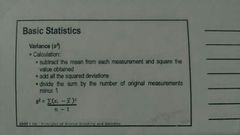
|
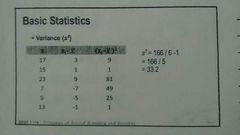
|
|
|
Mean or average |
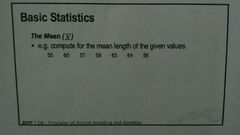
Provides info about the center of distribution |

|
|
|
Standard deviation or s |
Describes variability of measurements |
Square root of variance and unit is same as original measurements |
|
|
Mean and SD |
Normal distribution symmetrical shape are described by these |
|
|
|
Normal distribution |
A symmetric distribution where most of observations cluster around central peak and probabilities for values further away from mean taper off equally in opposed directions |
|
|
|
Normal distribution |
Probability function describing how values of variables are distributed |
|
|
|
Empirical rule / three-sigma rule / 68-95-99.7 rule |
Provides quick estimate of data spread in a normal distribution given the mean and SD |
|
|
|
Empirical rule |
Applies generally to random variable, X, following the shape of normal distribution or bell-curve with a mean "mu" and SD "sigma" |
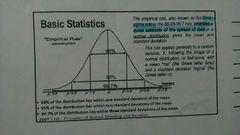
|
|
|
Empirical rule |
Used as rough gauge of normality; when number of data points fall outside three SD range, it indicates non-normal distributions |
|
|
|
Correlation |
Relationship between two characteristics or variables |
|
|
|
Correlation coefficient |
Measures strength of association of two characteristics |

|
|
|
Covariance |
Measures variables with different units of measurements |

|
|
|
COMPARATIVE TABLE |

|
|
|
|
Covariance |
Measure used to indicate extent to which two random variables change in tandem |
|
|
|
Correlation |
Represents how strongly two random variables are related |
|
|
|
Covariance |
It is nothing but a measure of correlation |
|
|
|
Correlation |
Scaled form of covariance |
|
|
|
Value of correlation |
Its values may lie between -1 and +1 |
|
|
|
Value of covariance |
Value may lie between -inf and +inf |
|
|
|
Covariance |
It is affected by change in scale like if all value of one variable is multiplied by a constant and all value of another variable are multiplied by a same or different constant, it is then changed. |
|
|
|
Correlation |
Not influenced by change in scale |
|
|
|
Correlation |
It is dimensionless like it is a unit-free measure of relationship between variables |
|
|
|
Covariance |
Value is obtained by the product of units of two variables |
|
|
|
Correlation indicates only that the variables are associated due to these |
1. Does not imply cause and effect relation 2. Does not mean values of two variables are same but only tells that change in one variable associated with proportional change in the other |
|
|
|
Positive value |
There is a direct association between variables |
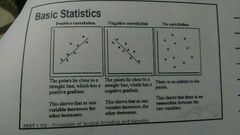
|
|
|
Negative value |
There is an inverse association between two variables |
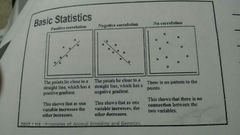
|
|
|
Zero value |
It means no association between variables |
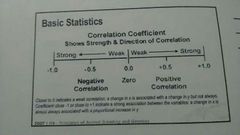
|
|
|
Correlation coefficient |
A statistical measure that calculates strength of relationship between relative movements of two variables |

|
|
|
Regression |
Allows to statistically predict the characteristics of offspring from a given mating even without knowledge of genotypes that encode the characteristics |
|
|
|
Regression coefficient |
Indicates how much y increases on average per increase in x |

|
|
|
Regression line |
Defines relation between x and y variables and it serves as a line that best fits all points on a graph |

|
|
|
Y intercepts |

|
|
|
|
Correlation coefficient |
Measures strength of association between two variables, signs indicate direction of correlation while absolute value measures strength of association |
|
|
|
Regression |
Used to predict value of one variable on the basis of value of correlated variable |
|
|
|
Heritability |
Proportion of total phenotypic variation due to genetic differences |
|
|
|
Nature of difference |
It is important in profitability for dairy farming as some cows produce consistently more milk than others |
|
|
|
Can be done |
If largely due to genetics, selective breeding |
|
|
|
Has no effect |
If environment, selective breeding |
|
|
|
True |
Phenotypic variation in characteristic must be partitioned into components attributable to different factors |
|
|
|
Phenotypic variance (Vp) components |
1. Genetic variance 2. Environmental variance 3. Genetic-environmental interaction variance |
|
|
|
Genetic variance or Vg |
Differences in genotypes among individual members of population Vg = Va + Vd + Vi |
|
|
|
Environmental variance or Ve |
Environmental differences such as light and water or variation in phenotype that is not inherited |
|
|
|
Genetic-environmental interaction variance or Vge |
Effect of a gene depends on specific environment in which it is found |
|
|
|
Components of genetic variance |
1. Additive genetic variance or Va 2. Dominance genetic variance or Vd 3. Genetic interaction variance or Vi |
|
|
|
Additive genetic variance or Va |
Summed together to determine overall effect on phenotype |
|
|
|
Additive genetic variance or Va |
Primarily determines resemblance between parents and offspring with intermediate phenotype |

|
|
|
Dominance genetic variance or Vd |
Effect of an allele depends on the identity of the other allele at that locus |
|
|
|
Dominance genetic variance or Vd |

Uses upper or lower case letters to indicate dominant and recessive allele |
|
|
|
Va and Vd computation |

|
|
|
|
Genetic interaction variance or Vi |
Genes at different loci interact in the same way that alleles at same loci interact |
E.g. Labrador haircoat |
|
|
Summation equation |
All components of phenotypic variance or Vp describes potential causes of differences observed among individual phenotypes |

Vp = Va + Vd + Vi + Ve + Vge |
|
|
Genetic variance |
Vadd, Vepi, Vdom |

|
|
|
Vadd |
Phenotypic variance due to additive effects of alleles |
|
|
|
Vdom |
Phenotypic variation due to dominance effects when the affect of allele depends on the identity of the other allele at that locus |
|
|
|
Vepi |
Phenotypic variation due to epistatic effects when effect of allele depends on the identity of alleles at different loci |
|
|
|
Environmental variance |
Venv, Vcom, Vmat |

|
|
|
Venv |
Phenotypic variance due to random environmental influences |
|
|
|
Vcom |
Phenotypic variance due to common family influences |
|
|
|
Vmat |
Phenotypic variance due to maternal influences |
|
|
|
Heritability or h2 |
Proportion of phenotypic variation due to additive effects of alleles or how much Vp is made by Vadd |
|
|
|
Types of heritability |
1. Broad-sense heritability or H2 2. Narrow-sense heritability of h2 |

|
|
|
Broad-sense heritability or H2 |
Proportion of phenotypic variance due to genetic variance |
|
|
|
Narrow-sense heritability or h2 |
Propprtion of phenotypic variance due to additive genetic variance |
|
|
|
Importance of narrow-sense heritability |
1. Additive effects are transmitted to next generations 2. Dominance (interaction between alleles within same locus) and epistasis (interaction between loci) varies between generations 3. Epistasis effects are small and can be neglected |

|
|
|
Some ways on measuring heritability |
1. Eliminate one or more variance components 2. Comparing the resemblance of parent and offspring 3. Comparing phenotypic variances of individuals with different degrees of relatedness 4. Measuring the response to selection |
|
|
|
Limitations of heritability |
1. Heritability does not indicate degree to which characteristuc is genetically determined 2. Individual does not have heritability 3. No universal heritability 4. Even when high heritability, environmental factors may still affect 5. Heritabilities indicate nothing about the nature of population differencesbin a characteristic |

|
|
|
Correlatef responses |
Phebotypic and genetic correlations |
|
|
|
Phenotypic correlations |
Corrwlation between two phenotypes due to environment or genetic correlation |
|
|
|
Genetic correlations |
May cause phenotypic correlation since genes affecting two characteristics are associated |
Can be + or - like height and hand size |

